Archaeological Areas of Pompeii, Herculaneum and Torre Annunziata: The ancient Roman towns of Pompeii and Herculaneum were founded in the 6th century BC. Pompeii, Herculaneum Torre Annunziata were devastated by a heavy eruption of the Vesuvius in 79 AD. The ruins of Pompeii, Herculaneum and Torre Annunziata are situated in the shadow of the Vesuvius. The Vesuvius is a volcano on the west coast of Italy. Pompeii and Herculaneum remained undisturbed beneath the ashes until the first excavations in 1748 and 1860. Pompeii has still not been fully excavated and about 75 % of the buildings of Herculaneum are yet to be excavated. The Villa of Poppaea was also destroyed by the eruption of the Vesuvius in 79 AD. The Villa of Poppaea is situated in the ancient Roman town of Oplontis, modern Torre Annunziata. Oplontis was excavated in the period 1964-1984. The Archaeological Areas of Pompeii, Herculaneum and Torre Annunziata are situated near Naples. Most of the objects found in Pompeii, Herculaneum and Torre Annunziata are housed in the Naples National Archaeological Museum.The Archaeological Areas of Pompeii, Herculaneum and Torre Annunziata were declared a UNESCO World Heritage in 1997. Another archaeological area is Aquileia, probably the largest Roman city in Italy yet to be excavated.
www.werelderfgoedfotos.nl © Copyright World Heritage Photos
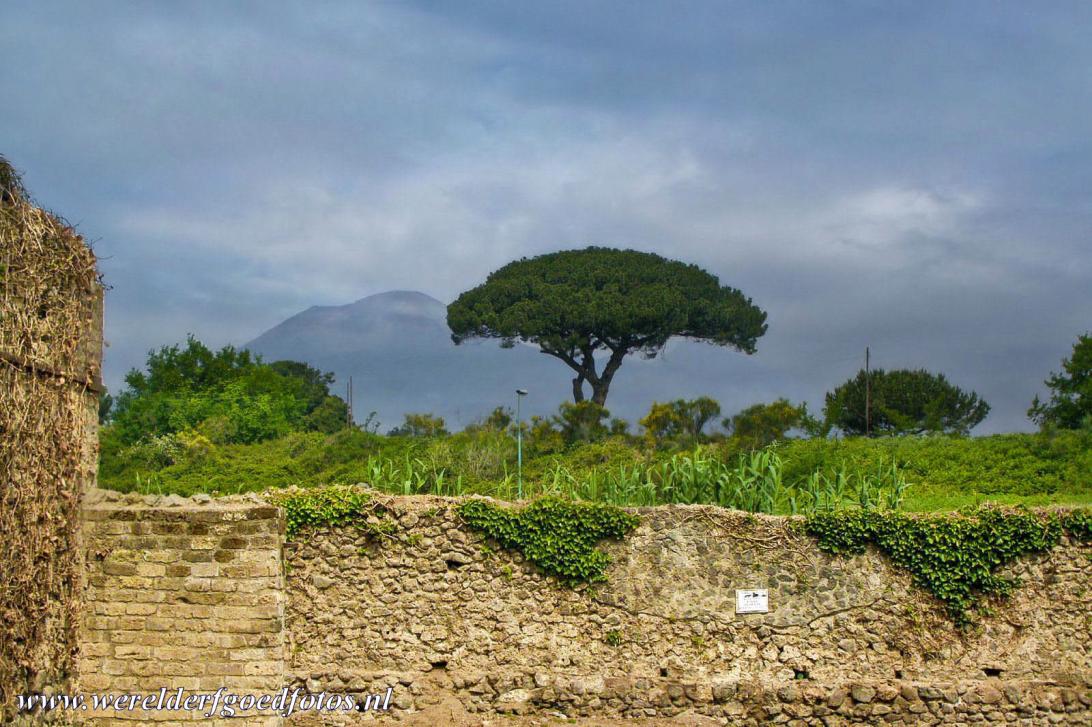
Ancient Pompeii with Mount Vesuvius in the background. Pompeii, Herculaneum and Oplontis, modern Torre Annunziata, were devastated by an eruption of the Vesuvius in 79 AD. The heavy eruption may have killed more than 16,000 people. Even nowadays, Mount Vesuvius is one of the most dangerous volcanoes in the world. The Archaeological Areas of Pompeii, Herculaneum and Torre Annunziata gained the status as a UNESCO World Heritage in 1997.

Ancient Pompeii with Mount Vesuvius in the background. Pompeii, Herculaneum and Oplontis, modern Torre Annunziata, were devastated by an eruption of the Vesuvius in 79 AD. The heavy eruption may have killed more than 16,000 people. Even nowadays, Mount Vesuvius is one of the most dangerous volcanoes in the world. The Archaeological Areas of Pompeii, Herculaneum and Torre Annunziata gained the status as a UNESCO World Heritage in 1997.
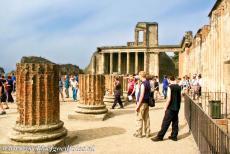
Archaeological Areas of Pompeii, Herculaneum and Torre Annunziata: The ruins of Pompeii are situated a few kilometres south of Mount Vesuvius. Pompeii was devastated by an eruption of the volcano Vesuvius in 79 AD. Pompeii remained undisturbed beneath the ashes until the first excavations in 1748. The Archaeological Areas of Pompeii, Herculaneum and Torre Annunziata were inscribed on the UNESCO World Heritage List in 1997.
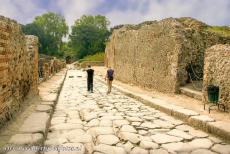
Archaeological Areas of Pompeii, Herculaneum and Torre Annunziata: The 900 metres long Via dell'Abbondanza. In the ancient times of Pompeii, the streets were very dirty, waste was thrown onto the street, but stepping stones allowed people to cross the street without stepping in the waste water and dirt, on each side of the street were raised sidewalks, the spaces between the stepping stones allowed carriages to pass along the road.
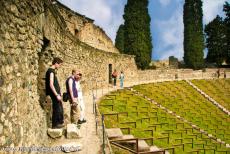
Archaeological Areas of Pompeii, Herculaneum and Torre Annunziata: The Great Theater of Pompeii was built into a natural hill in the 2nd century BC. The theater could seat almost 5,000 spectators. The seats in the lower section of the theatre were reserved for senators, magistrates and other important people, the middle section was reserved for the middle class, the top seats were for plebeians. The Great Theater in Pompeii was used for comedies and tragedies.
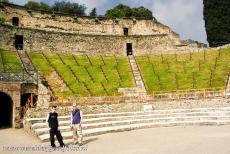
Archaeological Areas of Pompeii, Herculaneum and Torre Annunziata: The Great Theater in Pompeii. The ancient towns of Pompeii, Herculaneum and Torre Annunziata were destroyed by the same eruption of the Vesuvius, a large cloud of volcanic ash was driven by the wind towards Pompeii, the roofs collapsed by the weight of the ash, Pompeii was buried under a thick layer of volcanic ash. Herculaneum was buried by six lava flows. Most people had no time to flee.
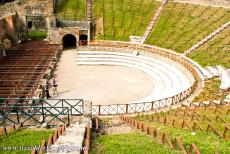
Archaeological Areas of Pompeii, Herculaneum and Torre Annunziata: The Odeon was a small theater in Pompeii, it was built in 80 BC and could accommodate at least 1,000 spectators. The Odeon was used for concerts and performances of pantomime. Pompeii was founded around 600 BC, the town was devastated by an eruption of the Mount Vesuvius in 79 AD, Pompeii was buried under millions of tons of volcanic ash. The ruins of Pompeii were discovered in 1594.
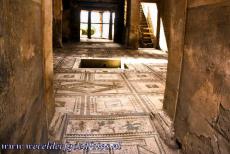
Archaeological Areas of Pompeii, Herculaneum and Torre Annunziata: The House of the Tragic Poet is a characteristic second century Roman house in Pompeii, this patrician house has been named after a mosaic depicting a theatre scene. The house is well-known for its frescoes and mosaics, the decorations were made after the earthquake of 62 AD, the earthquake may have been the forerunner to the eruption of Vesuvius in 79 AD.
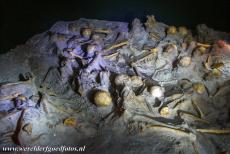
Archaeological areas of Pompeii, Herculaneum and Torre Annunziata: The remains of more than 1,500 people have been found at Pompeii and Herculaneum. Before the eruption of Mount Vesuvius, Pompeii was a favourite holiday destination for rich Romans. The eruption destroyed Pompeii and Herculaneum in 79 AD and also the ancient Roman town of Oplontis. The eruption was described by an eyewitness, Pliny the Younger.
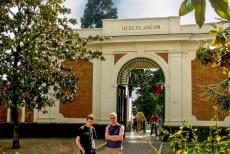
The entrance into the archaeological area of Herculaneum. The ancient Roman city was situated between Naples and Mount Vesuvius, In 79 AD, Herculaneum was destroyed by the lava flows of Mount Vesuvius. The heavy eruption lasted 24 hours. Herculaneum was buried under 23 metres of lava. Mount Vesuvius is still an active volcano and it is regarded as one of the most dangerous volcanoes in the world. The last eruption of the Vesuvius took place in 1944.
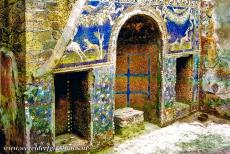
Archaeological areas Pompeii, Herculaneum and Torre Annunziata, an UNESCO World Heritage: The house containing the mosaic of Neptune and Amphitrite in Herculaneum was probably the house of a wealthy family, the house is richly decorated The wall near the lararium is adorned with floral designs and deer being chased by dogs. A lararium is a shrine to the guardian spirits of an ancient Roman household.
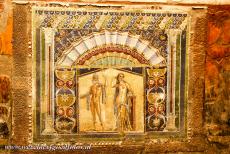
One of the houses in Herculaneum is called the House of Neptune and Amphitrite. One of the walls in the nymphaeum, a room consecrated to the water nymphs, is decorated with a mosaic of the sea-god Neptune and his wife Amphitrite, the house has been named after this mosaic. The dining area of this house is also decorated with wall mosaics. The Archaeological Areas of Pompeii, Herculaneum and Torre Annunziata were declared a UNESCO World Heritage.
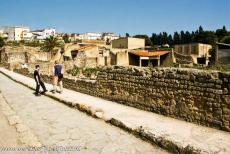
Archaeological Areas of Pompeii, Herculanuem and Torre Annunziata: The Archaeological Area of Herculanuem. Herculaneum was devastated in 79 AD by an eruption of he volcano Vesuvius. The remains of the buried city were discovered in 1709. The major excavation in Herculaneum started in 1927. Most of the buildings of Herculaneum are yet to be excavated. About one-third of the town has been excavated.
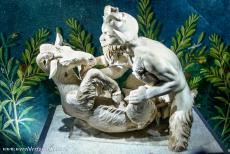
Archaeological Areas of Pompeii, Herculaneum and Torre Annunziata: This marble sculpture of the god Pan and a goat was found in Pompeii in 1752. Most of the objects that were discovered in Pompeii and Herculaneum have been removed, the Naples National Archaeological Museum houses most of the artifacts found at Pompeii and Herculaneum and also the original frescoes of Pompeii and Herculaneum.
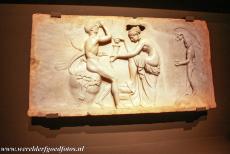
Archaeological Areas of Pompeii, Herculaneum and Torre Annunziata: A work of art found in Pompeii. Most of the objects found in Pompeii and Herculaneum are on display at the Naples National Archaeological Museum, one of the room is dedicated to the artwork of Pompeii and Herculaneum. The museum is considered the most important archaeological museum in Italy and one of the most important in the world.
